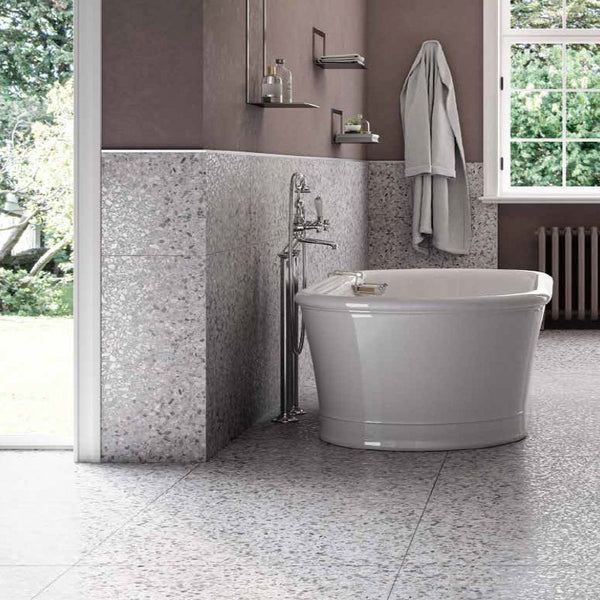How to renovate a bathroom step-by-step
Apr 19, 2022
Renovating a bathroom can be a major project but with some planning and organising, you can renovate your bathroom to look awesome yourself.
If you are tired of how the old bathroom looks in your house and considering a level-up, you have come to the right page. Here we show you how to do everything you need to do to renovate your bathroom step-by-step.
Table of Content
How To Choose the Best Tiles For Your Bathroom
How to Clean and Maintain Bathroom Tiles
How to Plan

Planning is everything.
When it comes to renovation, planning should be the number one priority. Your bathroom may not even need a full renovation and a simple re-arrangement could do the trick.
So, get your pen and paper out and start planning.
You need to keep these things in mind while planning:
Budgeting - estimate your budget and how much you can spend on this project. Then you will have a better idea about what to do next
Hiring a builder - decide on whether you want to hire a builder or you want to oversee the project yourself. You can do it on your own and make it more affordable. Consider your background, your budget and the size of the project. Ask around for more tips and guidance and decide on this early on.
Demolition - you most probably will end up going through a demolition process, so think it ahead. Demolition always comes with waste disposal. Keep that in mind as well.
Hiring tradesmen - Make a list of all the technicians you need to hire to get the work done. Some of them include an electrician, a plumber, a water proofer and a painter.
Measurements - this is key in making sure that everything that you plan goes accordingly. You can draw a plan on a piece of paper or if you are familiar with software make a 3d model of it on your computer with exact measurements.
Tiling - an important aspect of your plan. Think about what type of tiles would look good in your bathroom. If you are unsure of what to do you can always ask Stone and Tile Projects for consultancy.
Certificates of compliance - this depends on your council and town. Make sure you get all your paperwork done beforehand.
How Long Does a Bathroom Renovation Take ?
This is a hard question to answer, considering all the different factors that could impact the duration of the project.
To give a general time, we can say it should take about 4 to 5 weeks for an average size bathroom. This is however, a general estimation and each project has its own scenario.
There are multiple factors that could affect how long it takes for you to finish your job.
- The size of the project
- Workers delivering their job on time
If you ever talk to anyone who was done a renovation project, they will tell you the difficulties of actually getting builders and technical professionals on your time. They are busy people and the nature of the work is unpredictable, so they end up not finishing their previous projects on deadline to show up for yours.
This is why you should contact them as early as possible and expect the unexpected.
- Materials bing on-time and available
Sometimes you do get to bring the builders on time, but your materials have not arrived. Then you have to ask them to come again for another time. This whole cycle will take weeks or months.
Therefore, always prepare your materias in advance, and give the delivery extra time to avoid any such issues.
Cost

How much a bathroom renovation costs you depends on the work that you are going to do. It could be between a few thousands to 40,000 AUD.
The materials used, the plan of your bathroom and the team you work with are some of the factors for the overall cost of your bathroom renovation.
If you want to save money you can do DIY at some of the stages and choose more budget-friendly materials.
Remember to make an account entry for every bill you pay for. Recording all your expenditure is a smart way of managing expenses.
Tools and Materials Needed
If you want to get hands-on, you will need some basic tools. The list may be different for each project but here are some tools that will be useful:
- Safety mask
- Gloves
- Goggles
- Tape Measure
- Hammer
- Utility knife
- Chisel
- Hacksaw
- Bucket
- Screwdriver
- Pry bar
- Extension cord
- Power drill
- Adjustable wrench
- Spackle knife
- Caulking gun
- Chalk line
- reciprocating saw
You will need materials according to your plan but having these, in general, is a good idea as they will become handy:
- Silicon sealant
- Spackle
Design Ideas

Designing a bathroom is not all that easy. Here are some tips and ideas that you can use to begin designing:
Colour theme: Use a set of colours that are in harmony with one another. Don’t use colours that don’t go well and clash with each other aesthetically.
For example, blue is commonly used in the bathroom because of its soothing psychological effect, you can match it with green or grey, but orange may not be the colour to match it with. (This is of course a rough guide. You can choose whatever colour you like for your home!)
Buying new fixtures: Will you need a new sink, bathtub or mirrors or can you make use of the old ones? Try to figure this out during your planning stage as it will help you estimate your budget easier.
If you are planning on buying a new fixture, think about how they look, what colour are they and how much space they occupy.
Storage: If you think you already have enough storage then you have nothing to worry about, but if you want to have additional storage space, consider how you want it to be.
If you are expanding your bathroom, then you might be thinking about adding storage, see your floor plan and how the storage space plays out in your bathroom. Think about the ease of access to the storage when designing.
Utility: How are the utilities, especially electricity plugs, accessed in your bathroom? Make sure you think it through in your design. If you want to make any changes to the places of utilities in your bathroom, let your builder or technicians know about it. They can help you find the best solution.
How To Choose the Best Tiles For Your Bathroom

If you decide to use tiles in your bathroom, you should carefully consider your choices. Unlike tiles in other areas of your house, bathroom tiles are subject to moisture and require more cleaning and maintenance.
Fortunately, your options are not limited. Today, there are many tiles to choose from for your bathroom. There are some things to keep in mind. Here we run through them with you:
- Choose a style
First, figure out what you want to do. Search the web. See some catalogues. Get inspired.
Generally, there are three types of styles for bathrooms.
Hotel bathrooms: this is the neutral style in which black and white colours are used more often.
Geometric style: this is the style where geometric patterns are made with tiles, and they give out a unique and neat look.
Lastly, decorative style: This is the more playful and creative style where many stark colours are used to distinguish the bathroom.
- Choose your tile size
Deciding on how big you want the tiles to be is vital. The standard size for floor tiles is 300x300mm. You can find many floor tiles in different materials such as porcelain, ceramic and natural stone this size.
Choosing large tiles for your bathroom will make it seem grander and more spacious. One popular size for walls and floor tiles is 300x600mm. You will need less cutting for bigger floor grates this way.
You also have the option to choose hexagon shape tiles. This will make your bathroom more unique and elegant. These tiles usually come in 450x450mm size and there are many options to choose from.
- Don’t choose more than three types of tiles
Choosing more than one tile for your bathroom is a fantastic idea. It can help with your design and bring out an amazing look in your bathroom, but you don’t want your bathroom to look too messy.
Keeping your choices below three will help your mixing and matching tiles look better.
Try choosing your floor tiles first. Then move on to walls.
You can have a feature wall or accent if you like. Feature walls are the one wall that has a different design than the rest. Choose your feature wall last. Having a feature is a nice idea. It makes your bathroom stand out.
- Consider your shower space
You might want to have a separate shower space in which case having a set of different tiles for your shower is a good option to consider.
Think it through and make your decision. Try different things. Your shower might look better with the same tiles. Simplicity might be the answer. You just need to factor it in while you are designing and planning and make the best choice for yourself.
- Think about maintenance
Bathrooms are a place that requires more cleaning and maintenance than the rest of the house (okay maybe your kitchen also needs a lot of cleaning).
When choosing the materials for tiling your bathroom, consider maintenance. A lot of people choose affordable products that cost them more with the usual maintenance. If you pay a bit more when making your purchase but the product is low maintenance, you are saving money.
Step 1 - Make a Team
Renovating a bathroom requires the help of different technical professionals.
Get your team together. Try to get them to come and have a visit to your bathroom or send them photos and get some information on how their job would work out within your plan.
Get their feedback. Put it into your plan and make sure to schedule a time with them.
You will probably need:
- An electrician
- A plumber
- Builder
- Water proofer
- Painter
Usually, the first tradesman to start the work is the plumber, but sometimes having a builder come and oversee the project can help.
You might want to oversee the project yourself, in which case the plumber is going to be the first person to call.
Just make sure you have a good idea of what needs to be fixed and done before you ask anyone for quotes.
Step 2 - Demolition
Demolition is the act of de-attaching things and opening up space for renovation.
Before demolition, you need to disconnect first. For example, plumbers will dislocate the pipes, valves toilets and capping services, and electricians will cut the wires and remove power points.
These are usually how things start. Then, the builder will start the demolition.

The demolition process varies according to your project. It could include things like removing the bathroom screen and removing the tiles and floorboards.
This process is also known as “gutting”. You can do this on your own. Here are some tips if you are thinking about gutting your bathroom yourself:
- Begin your gutting by cutting the water. Then drain and remove the toilet to ensure you will not experience a spill
- If you are planning to remove your bathtub, cover the tub and start removing the bath tiles down to the stud. This step helps with rebuilding your plumbing with your new bathtub.
- If necessary, remove the insulation from the wall. Instead of using a hammer, you can use a reciprocating saw for cutting the panels. Make sure to wear safety gloves and a face mask to protect yourself.
- Remove all the vanity such as cabinets, mirrors and other features in your bathroom. Even if you are going to reinstall them again, it’s a good idea to take them out during the gutting to protect them from getting damaged or dirty.
Step 3 - Rough In
The technicians need to come and see your bathroom for making the necessary measurements and maybe do very initial parts of their work.
This is a vital part of the process as making sure all the measurements are correct and everything is going according to plans can save you a lot of time and money. Even a tiny measurement mistake will ruin your whole plan and increase the cost.
Step 4 - Walls and Floors

At this point, you can start installing the walls and floors finishes. This can be done with various materials, you might use tiling or cementing.
There is an order of work that should be followed. It goes like this:
- Installing plaster or cement sheets
- Waterproofing
- Tiling
- Grouting
- Painting
NOTE: Waterproofing is critical!
Make sure you get the right technician to do your waterproofing. Sometimes, your builder or your tiler knows how to do waterproofing. If that’s not the case, hire someone to do the waterproofing.
Not having waterproofed surfaces on the walls, floor or ceiling of your bathroom can ruin the whole project.
You can hire a professional to do the tiling or you can DIY. Tiling is not as difficult as you might think.
If your design does not include tiles, your job is even easier. Painting on top of cement is extremely easy (and it’s kind of fun too!). Just make sure to get the right colour and the right material and you shouldn’t have much of a problem.
Step 5 - Cleaning and Decorating

Once you are done with the surfaces, you need to let them rest for a while (especially if you have done the tiling and applied grout).
After a few days, you can start the final stage of a bathroom renovation: decorating.
Get your designer's glasses on and choose the best decoration to go with your bathroom. Keep your budget in mind and all the necessary items such as a bathroom sink, mirror, bathtub and other decorations.
The technicians will need to do a fit off. This is essentially making sure that all the services (such as power points and water pipes) are correctly connected and working. No fixture should be left out.
And after everything is settled and finished, you should do a deep clean. Just wash and clean everything until you are satisfied and can take a nice photo to show off your fantastic-looking bathroom.
How to clean and maintain bathroom tiles

The best way to keep a bathroom looking clean and shiny is by regularly cleaning it. Here we share some insider tips on how to maintain your bathroom tiles.
- Cleaning products
We recommend using Lithofin to clean your bathroom tiles. Lithofin offers a variety of products. You can use their Active Clean for cleaning your tiles and Grout Protector to clean the grouts on your tiles.
You can use any cleaning product you feel comfortable with. Some people prefer making their homemade cleaning materials with natural substances such as vinegar and salt. Our recommendation is Lithofin. Some products out there may not be very healthy to use so often in your bathroom.
Choose a product you feel comfortable with after doing your research.
What’s very important is that you clean your tiles regularly. This might be a little hard, but you will benefit from doing it in the long term.
- Dry out your tiles
You can do this by running a dry sponge on your tiles after taking a shower. By doing this you take the moisture away from your tiles. Keeping your tiles dry helps in maintaining them.
- Use hot water to clean the tiles
Using water at a higher temperature will help clean the tiles and grout easier. You can wet the tiles with hot water and let it be for a while then start the cleaning process.
- Clean once a week for better maintenance
Cleaning a bathroom once a week is the best advice for keeping your tiles clean and well maintained.
- Clean the grouts
The grouts between the tiles might become dirty or just turn darker as time goes by. You can use a different cleaning product from Lithofin that is specifically for grouts.
If you get stains on grouts Lithofin can do the job. However, if the stain has remained in place for a long time and Lothofin does not help, you can make use of bleach. Use it scarcity and make sure you don’t rub it on top of the tiles. Gently, use a toothbrush to just get the stain off the grouts.
Sometimes after a long time, you might see the grout coming off in which case you should repair the grout.
This is an easy task.
Mix the grout with water until it gets to toothpaste density. Apply the grout to the tiles. Then, remove excess grout. Use a damp sponge and remove the grout from the surface of the tiles. Make sure the cloth or sponge has minimal moisture, so it won’t dilute the grout.
Wait for the grout to dry and harden. Finally, apply silicone sealer to the grouts for further protection.
- Good ventilation
Ensuring that your bathroom has good ventilation helps with maintenance. If moisture stays in the bathroom for too long, it will cause problems.
- Act quickly on stains
Don’t let any spots or stains remain for too long. Clean them up as fast as you see them using cleaning products like Lithofin.



